Written by Antonio Femia | Photos by Antonio Femia and Alessandra Reale. Posted in Rides
Where southern Italy begins and the forests make way for arid lowlands with clay hills and sharp dolomitic rocks, Basilicata is a world best explored by motorcycle across its thousand twisties….
The great merciless summer heat has come, and this time the meteorologists have nicknamed it “Lucifer.” It’s not the best time for a motorcycle trip across one of the hottest regions of Italy, but reaching the cool Calabrian coast is a good excuse to cross Basilicata, the midway region where green forests and orchards make way for wide stretches of grain that, in August, take on the yellow hue of the desert.
Reaching the cool Calabrian coast is a good excuse to cross Basilicata, even during the “Lucifer” summer heat.
• A Brigands’ Land
Just after the Campania border is “The Vulture,” an area that takes its name from the mount overlooking it, an inactive but not extinguished volcano. The twin Monticchio Lakes lay along its slopes, a place for refreshing walks and visiting Badia di San Michele, a 10th century Benedictine monastery built in front of a large grotto. It’s not only famous for saints, but folk heroes. Not far from the monastery is another cave that was the shelter for Carmine Crocco—The Vulture’s legendary brigand.
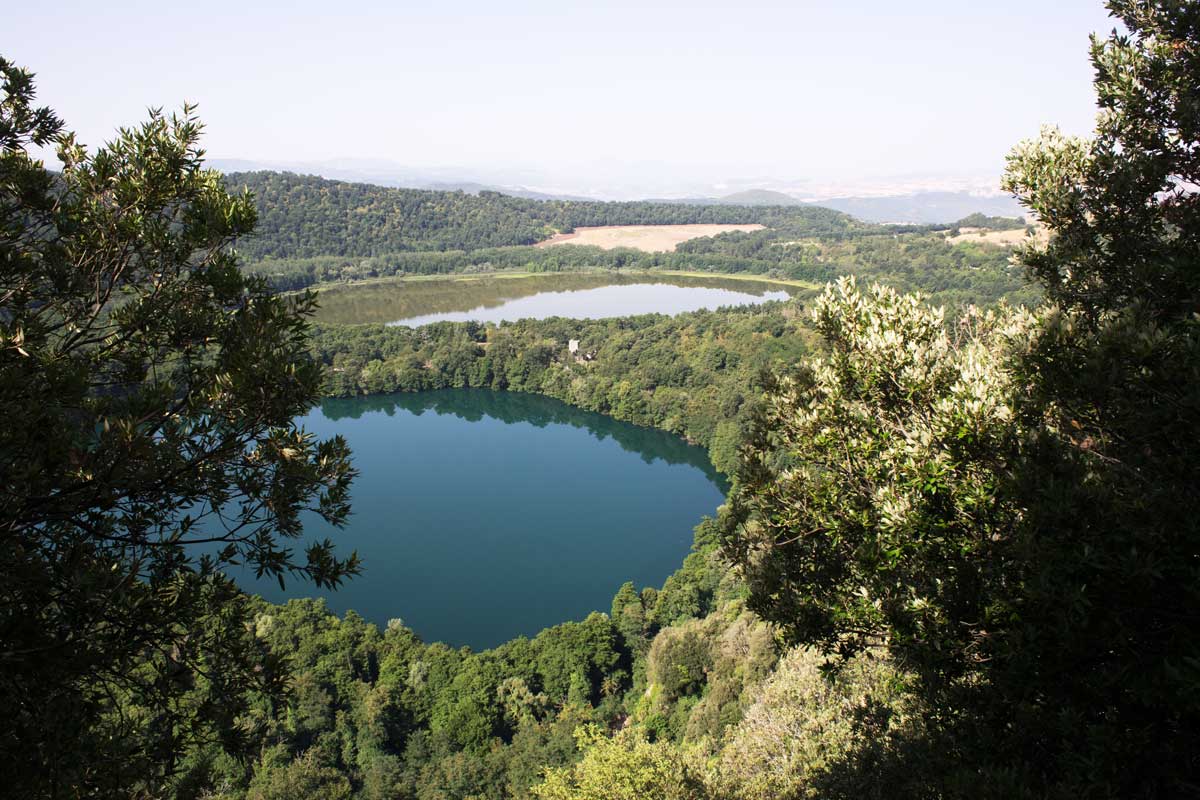 The twin Monticchio Lakes is a place for refreshing walks and visiting Badia di San Michele.
The twin Monticchio Lakes is a place for refreshing walks and visiting Badia di San Michele.
Italy’s unification came through military occupation, which provoked the rebellion of organized partisan bands, known as “brigands,” who made it difficult for the military to subjugate and control some regions. The rebellion was eventually eradicated and ended in a massive emigration to America. But nostalgic feelings and pride for the region’s heroic figures remain alive in popular culture, and the memory of the brigands still lives on a wine label produced in Rionero by Cantine D’angelo, a winery we visited. The unique character of their wine is attributed to the fertile volcanic ground of The Vulture, combined with the region’s unusual climate.
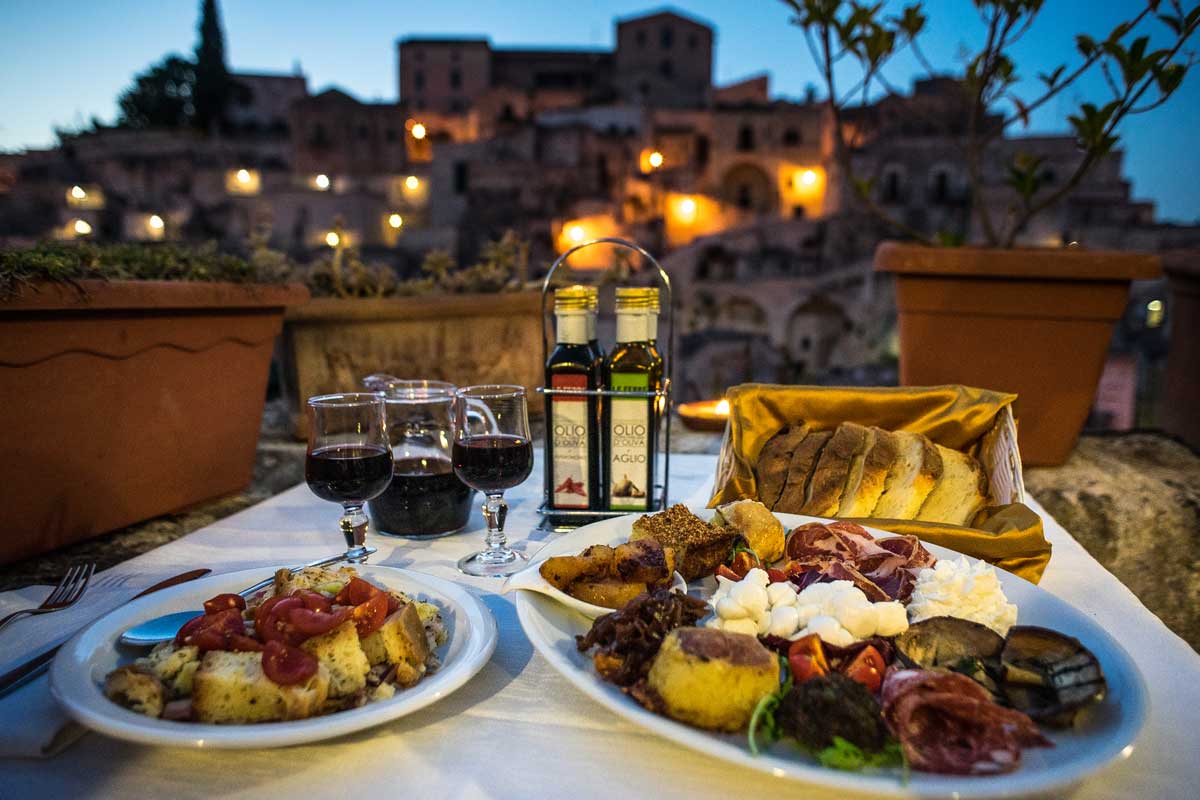 Traditional dishes are made with poor ingredients of agropastoral culture.
Traditional dishes are made with poor ingredients of agropastoral culture.
• The Arid Murgia
The Monticchio Lakes are surrounded by dense vegetation that reduces the heat in the rest of the region. We leave this cool paradise at 600 meters and ride down the windy SP90 road, as the greenery fades to the yellow arid plane of the Bradano River. We travel on the speedy and monotonous SS655, surrounded by clay hills covered by dried stubble waiting to be burned by farmers. As Lucifer blasts us with heat, we run close to the border with Puglia, glimpsing the Murge, the bare calcareous plateau hollowed by thousands of caves. Matera is our destination for the day; UNESCO declared Matera a World Heritage Site in 1993, but it later became globally famous when Mel Gibson’s The Passion of Christ revealed it as a frozen-in-time city, paving the way for economic and cultural rebirth.
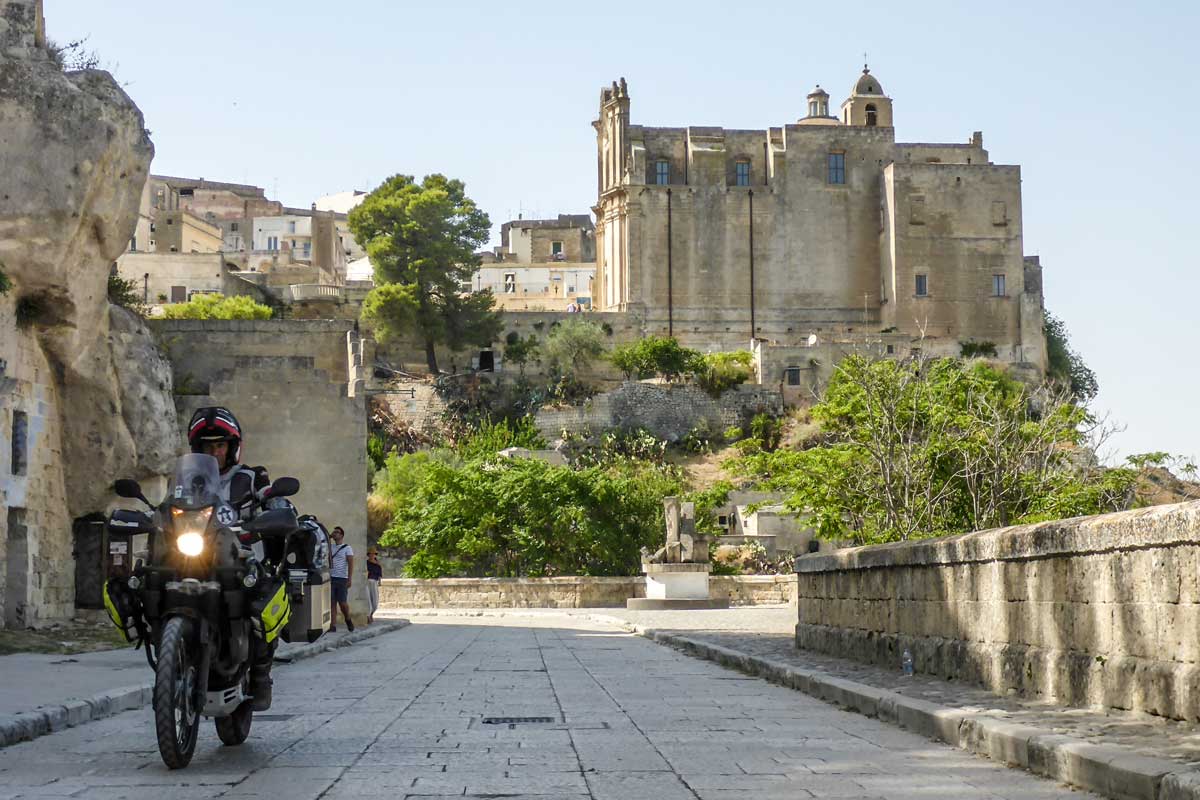 Along the stone paved alley running around the center of Matera. In the background is the rupestrian church of San Giuliano.
Along the stone paved alley running around the center of Matera. In the background is the rupestrian church of San Giuliano.
• The Limestone Oven
In 1945, following the publication of Carlo Levi’s Christ stopped at Eboli, public opinion became wildly outraged by the awful living conditions of southern Italy’s farmers. Sympathy ran high for Matera’s 20,000 inhabitants living in caves without windows, many sharing space with their animals, with no running water nor electricity and no shortage of malnutrition and malaria. This hopeless land saw the light after this book was released, effectively forcing the government to move the people to new settlements—one of the few mass movements in Italian history. But the caves are once again inhabited; now, many are homes and small hotels, some are museums of rural civilization.
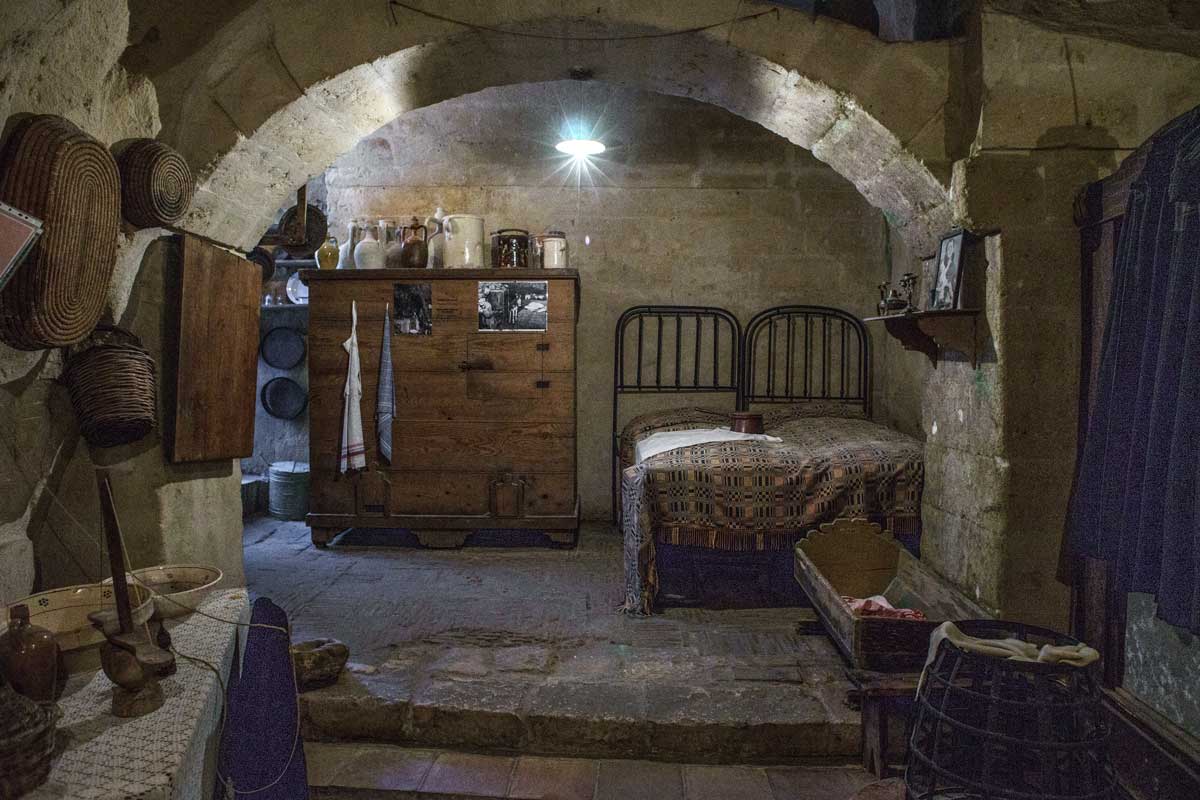 The interior of a typical Sasso in Matera is now a museum of rural civilization. Here people lived together with animals and had no running water or electricity.
The interior of a typical Sasso in Matera is now a museum of rural civilization. Here people lived together with animals and had no running water or electricity.
The modern concrete city, built around the ancient aristocrat palaces and a cathedral, sits atop of Sassi (Italian for “stones”) that inhabitants have been excavating since the Palaeolithic era.
The essence of this land, once an afterthought to the rest of Italy, is all discernible in the Sasso Caveoso district. You can see it through emptiness of the caves, the humble house façades built stone by stone over centuries, and enormous rainwater catchment tanks in the womb of the mountain. The Santa Maria de Idris church, along with the city lights, illuminates the starry night skies that contrast with the deep darkness of the Gravina canyon surrounding the area.
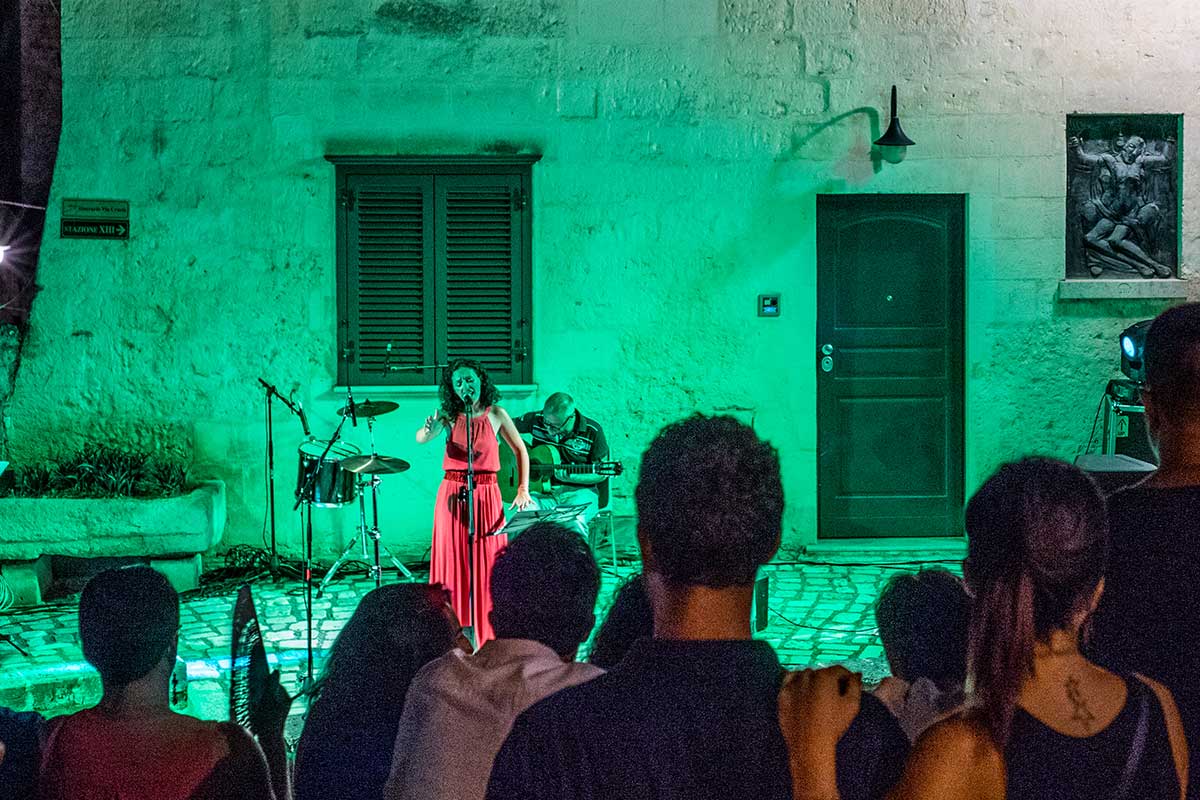 Enjoying night life in the streets of Matera.
Enjoying night life in the streets of Matera.
• Cooled on the Dolomites
At 45°C, the city becomes a gigantic oven cooking us slowly. It’s time to move onto a cooler environment, the parklands of the Dolomiti Lucane mountains. The small towns of Castelmezzano and Pietrapertosa sit among grey sharp peaks rising from a green carpet of oaks. These days, the villages are connected by the Angel’s Flight, a zipline that flies at 100 km/h over the impressive landscape. Visitors from everywhere animate the streets of these hamlets; the villagers love chatting, happy to share everyday life moments.
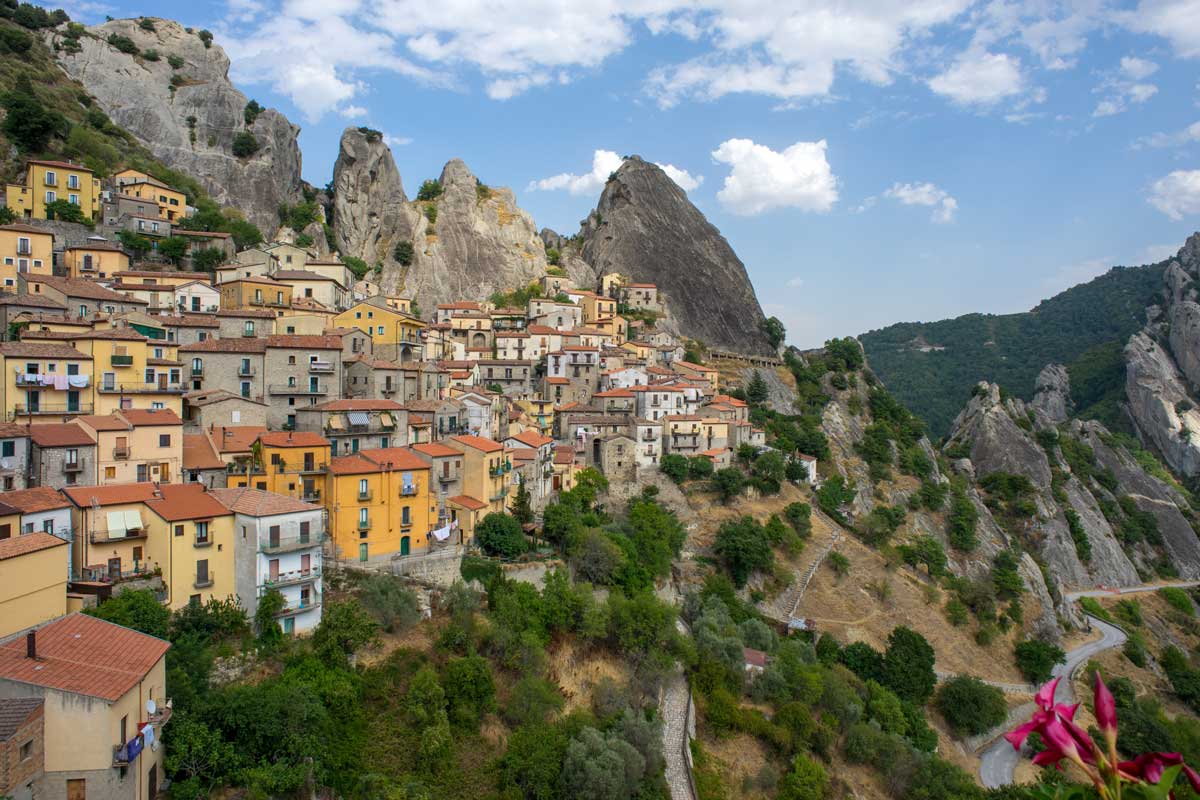 Castelmezzano is built upon solid rock like its twin Pietrapertosa. The two villages are connected via a zipline named Angel’s Flight.
Castelmezzano is built upon solid rock like its twin Pietrapertosa. The two villages are connected via a zipline named Angel’s Flight.
At the time of the Saracene incursions, the Arab captain Bomar built the military blockade, Arabata, on the high side of Pietrapertosa. It’s been inhabited since the 8th century BC and still has unique artifacts such as the original set-in-stone stairways. To get away from the overseas invaders, the legendary shepherd Paolino founded the town of Castelmezzano, also called Castrum Medianum by Normans who built a castle there some years later. Today only a few traces remain. The winding road linking the two villages is closed for a landslide, so we instead lose ourselves in the sweet countryside among lonely farms and cow herds, enjoying the hundreds of turns of the broken road.
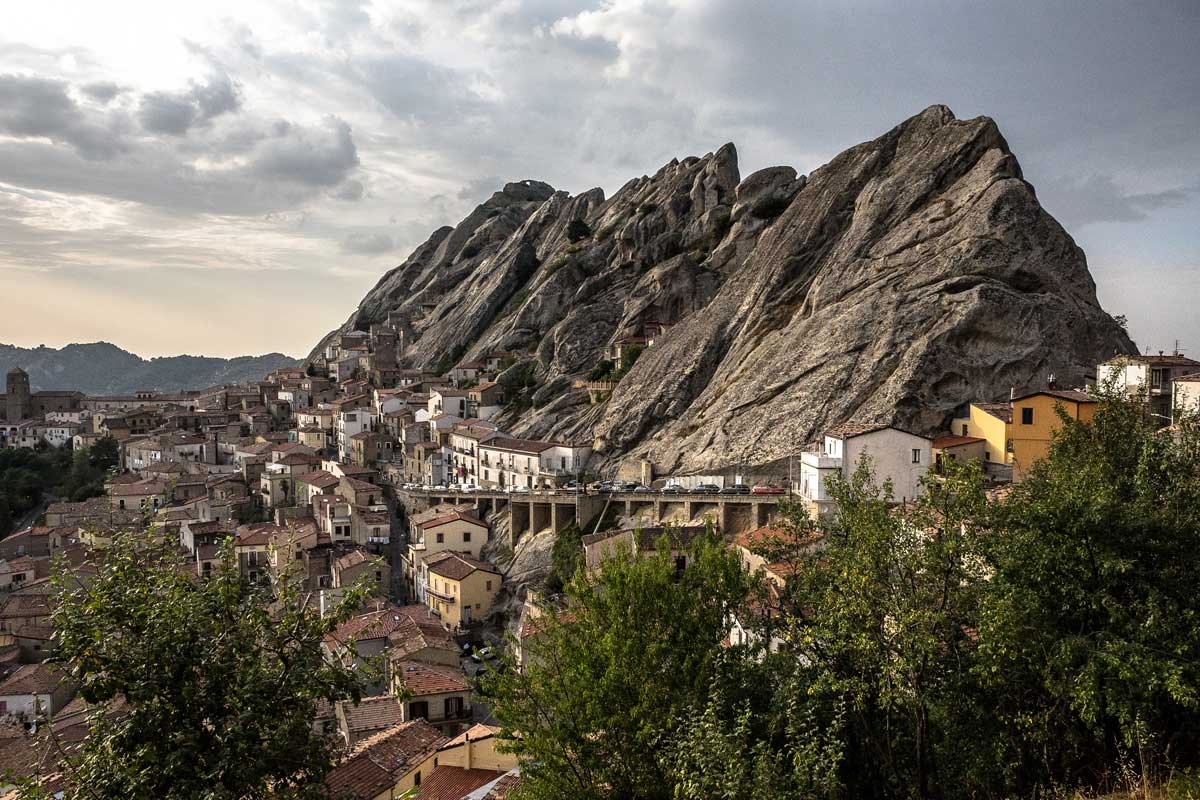 Pietrapertosa is famous for hosting a military blockade founded in the 10th century by the Arab captain Bomar.
Pietrapertosa is famous for hosting a military blockade founded in the 10th century by the Arab captain Bomar.
• The World of Badlands
The Acettura Wood in the heart of the park, shelter us from Lucifer’s hot grip for a couple of hours; sunrays break through the dense foliage, giving a sense of magic to the windy road crossing the forest.
Breaking into clear skies and dazzling light again as we ride the SP103 through Stigliano, we see two contrasting landscapes. On the right, green woods and orchards extend south in the direction of Pollino Mount. On the left, there is barren blasted countryside, a clay carpet fading to the pale sky at the horizon. We continue on into this landscape, among mud badlands modelled by winter rains. The ground is soft as butter, resulting in incessant landslides that constantly change the topography.
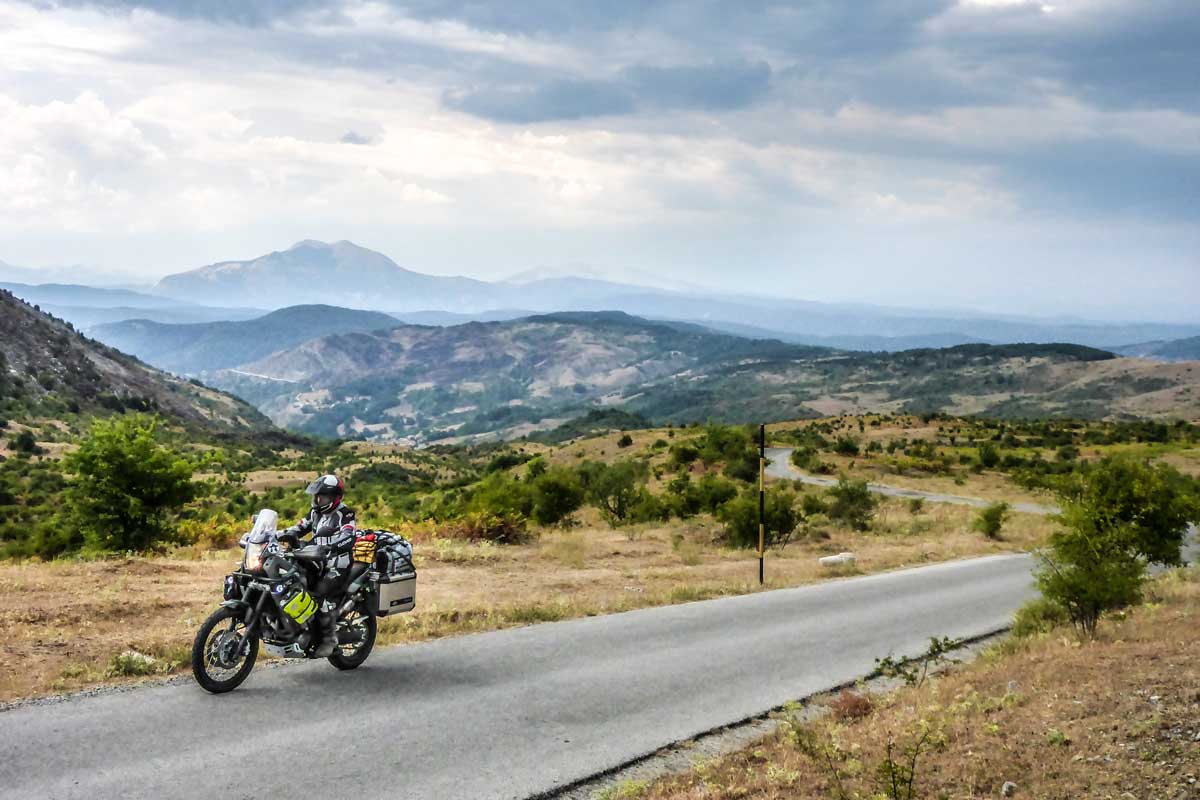 Entering Calabria through the high pastures of Mount Pollino.
Entering Calabria through the high pastures of Mount Pollino.
We stop in Craco, abandoned since 1963 after one too many landslides, never to be inhabited again. Like Matera, these days it’s often a set for movies and commercials. We finally reach the city of Pisticci, also built upon clay elevations. Despite the dangerous location, its inhabitants insist upon living on that wonderful terrace above the Cavone Valley. And after seeing the moon rising from the Jonian Sea, it’s easy to understand why. Here they live at a calm southern Italian pace, where families stroll along the avenue while elders chat; in the backstreets, women sit outside their home doors discussing the daily gossip about fellow countrymen. I’m envious of their simple way of life.
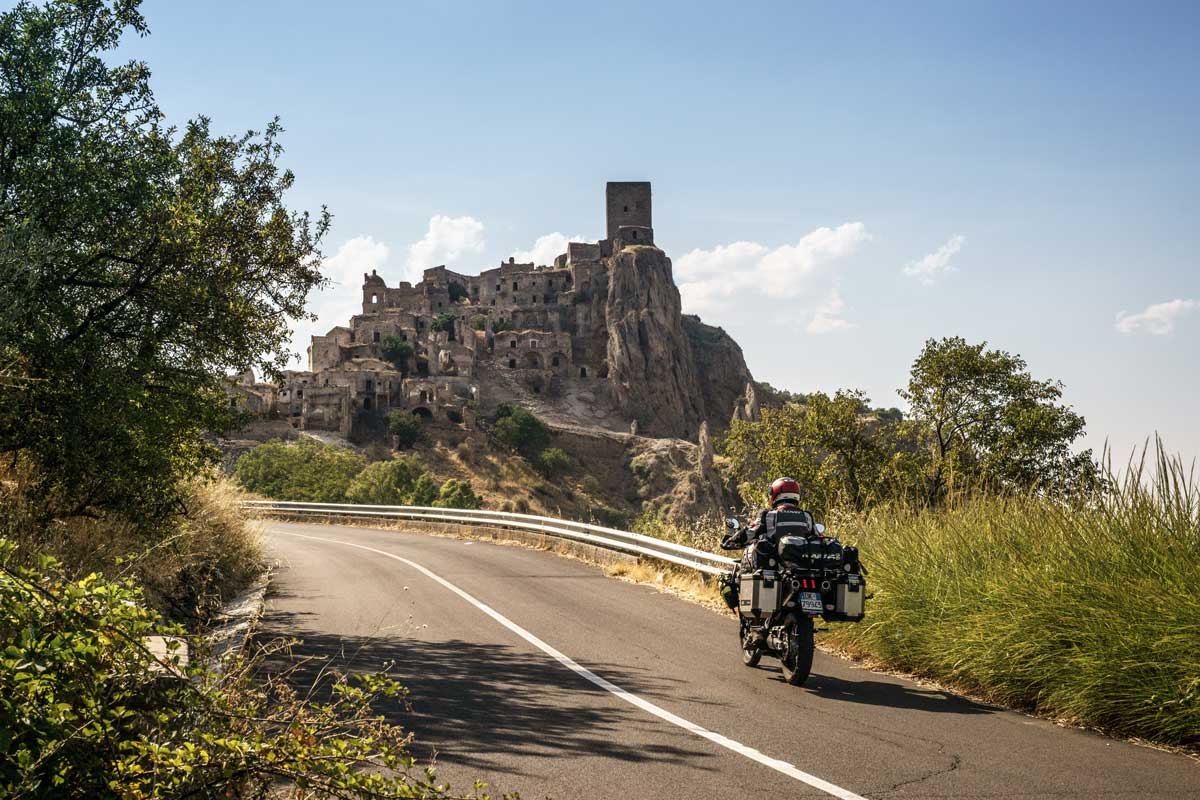 The village of Craco has been abandoned since the 1960s because of the many landslides.
The village of Craco has been abandoned since the 1960s because of the many landslides.
We could enter Calabria along the coastline, but instead go for the coolness of Mount Pollino, which separates Basilicata from Calabria. On both sides of this mountain, many towns still practice the ancient “Maggio,” a sort of tree wedding, a pagan ritual where the top of a fir is put on a beech transported by a pair of oxen. This long and complex fertility ritual, coinciding with the days of Christian festivities and season changes, is a symbol of identity for anyone from there.
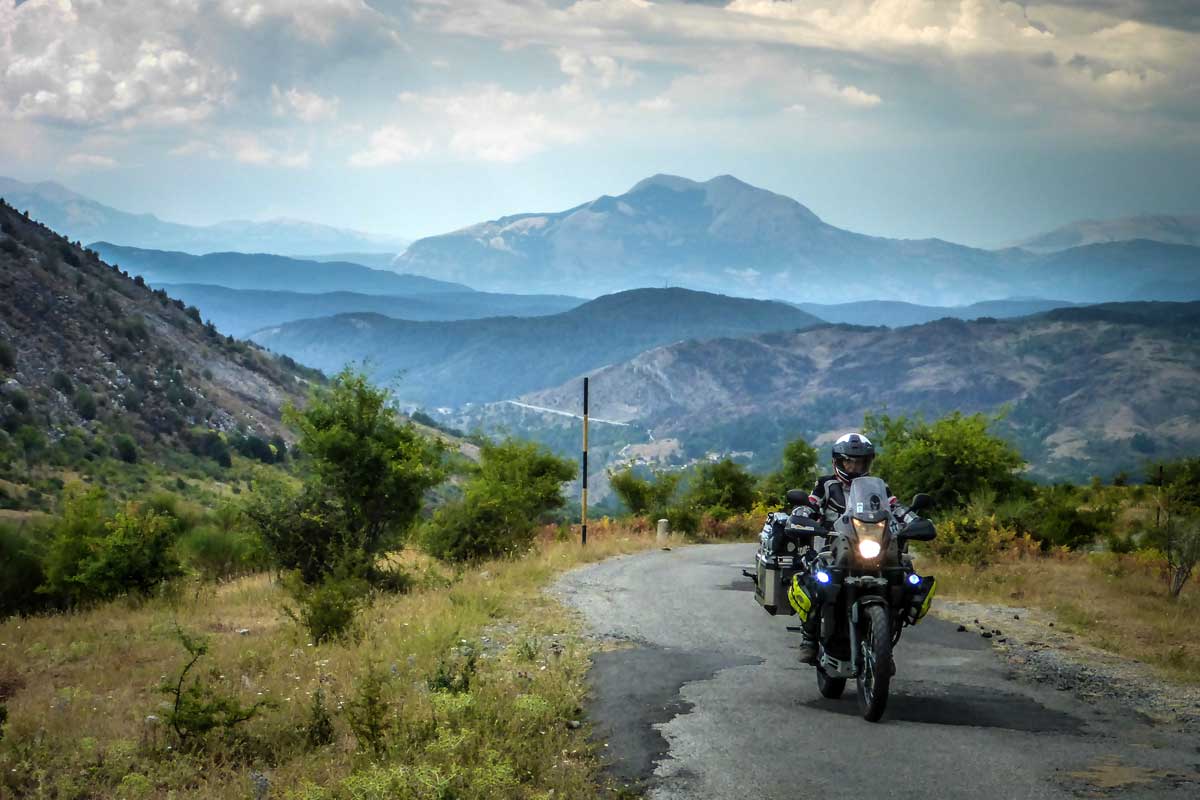 Another view of entering Calabria through the high pastures of Mount Pollino.
Another view of entering Calabria through the high pastures of Mount Pollino.
For us, it’s time to get our revenge on Lucifer, who hadn’t given us a break since we left. Once we cross the Pollino, we take the motorway quickly to the coast, where the crystal water of the Ionian Sea awaits us.
• Eat and Sleep:
In Basilicata you can find accommodations for every price and level. We suggest basing in the many B&B and farms where you can get to know the local culture better, but at more economic prices. Many are managed by young owners who made the decision to stay and work in their homeland.
– Rionero in Vulture:
Borgo Villa Maria—Località Monticchio Laghi, 85028 Rionero in Vulture | BorgoVillaMaria.com
Very close to Monticchio Lakes, this wide-roomed hotel is surrounded by woods, with a safe parking for motorcycles. Maria, the young owner, is ready to give you plenty of information about what to visit and things to do there.
Casa Vinicola D’Angelo—Via Padre Pio, 8, 85028 Rionero in Vulture PZ | DangeloWine.com
An excellent winery where you can taste a good wine, exported all over the world. The young owners, who maintain their ancient family business, arrange wine tastings in the vineyard where motorcyclists’ groups are welcome.
– Matera:
Dimora Santa Barbara—Piazza Duomo, 75100 Matera | bbsantabarbara.it
A refurbished aristocrat palace in the center of Matera, near by the Cathedral with a stunning view over the Sassi and the Gravina. Owner Angelo is a passionate biker; he served as our guide around the city to visit hidden treasures.
Ristorante La Cola-Cola—Via Spartivento 21, 75100 Matera | LaColaCola.it
Dishes from the Murgiana tradition, poor but tasty, prepared as grandmothers used to do. The terrace has a stunning view over the Sassi.
– Dolomiti Lucane:
Agriturismo Grotta dell’Eremita—C.da Calcescia, 1 – 85010 Castelmezzano (PZ) | GrottaDelLeremita.com
This farm is out in a strategic location near the main route and the Dolomiti Lucane. It often hosts groups of bikers thanks to its 50 available rooms. Its restaurant serves traditional dishes prepared by its own products.
– Pisticci:
Il Calanco a Pisticci—Contrada S. Lucia, 75015 Pisticci (MT) | IlCalanco.it
This agritourism spot is led by a historic family of breeders and includes a stud and a stable. Its restaurant serves dishes from local products and the owners are happy to talk about their culture.
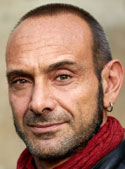 Antonio Femia is an Italian travel journalist and photographer. He jumped on the saddle at the age of thirty and never went down, using motorbike as a tool to discover the world. He quitted as an architect at the age of forty for dusty roads to ride on his bike, searching for beauty mostly where it’s not supposed to be. www.totolemoto.it
Antonio Femia is an Italian travel journalist and photographer. He jumped on the saddle at the age of thirty and never went down, using motorbike as a tool to discover the world. He quitted as an architect at the age of forty for dusty roads to ride on his bike, searching for beauty mostly where it’s not supposed to be. www.totolemoto.it


